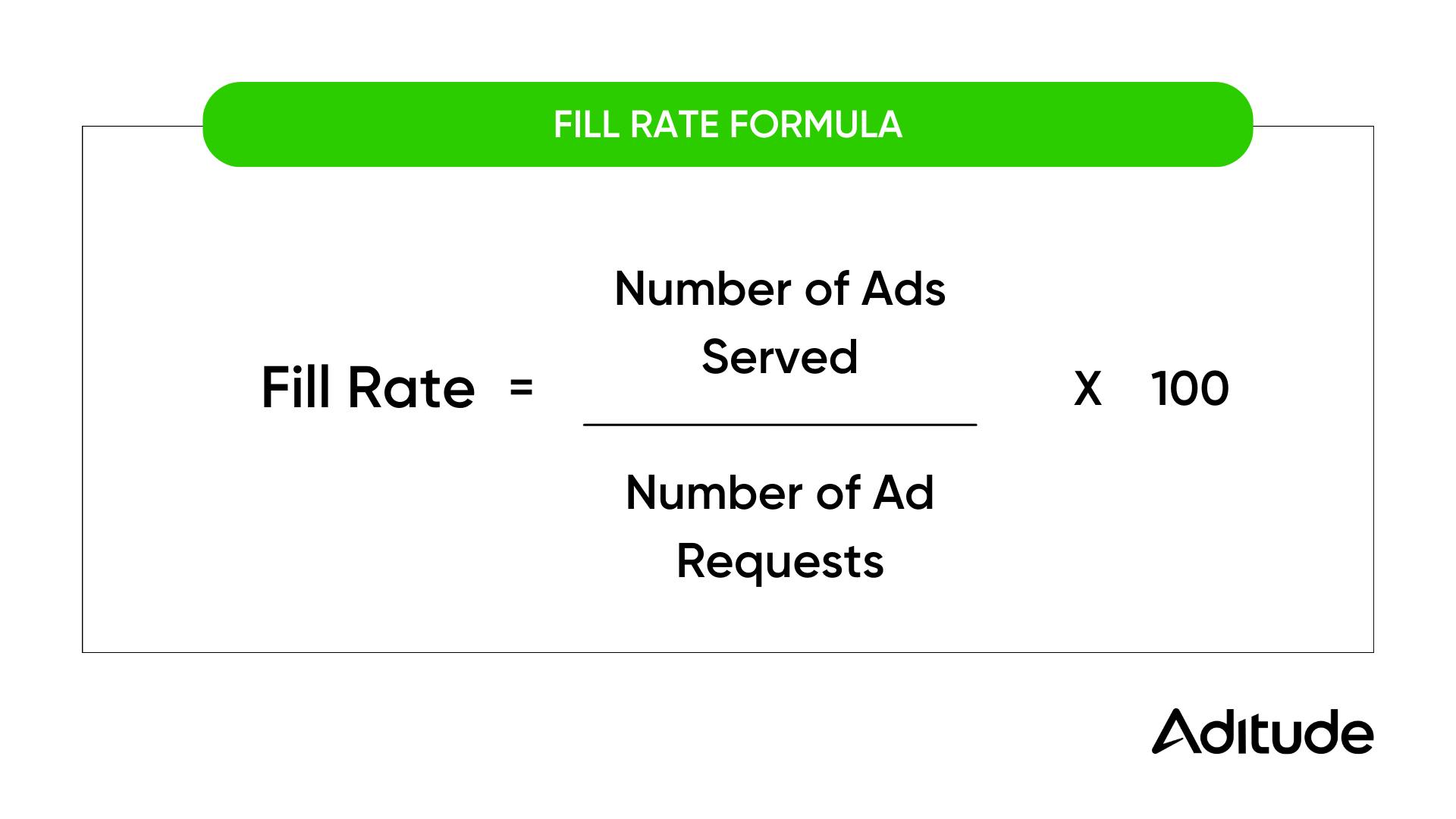How to Improve Ad Fill Rates
Ad fill rate is a crucial metric that can make or break your monetization success. Whether you're an experienced publisher or just getting started, grasping this metric and learning how to optimize it can greatly influence your bottom line.

One of the key metrics that can make or break your monetization efforts is the ad fill rate. Whether you're a seasoned publisher or just starting out, understanding this metric and how to improve it can have a significant impact on your bottom line. In this comprehensive guide, we'll break down the ad fill rate, explore why it might be low, and discuss strategies to improve it, ultimately helping you boost your ad revenue.
What is an Ad Fill Rate?
Simply put, the ad fill rate is the percentage of ad requests that are successfully filled with ads. When a website, app, or any digital property requests an ad from an ad network or demand partner, the fill rate shows how often that request is actually met with an ad. It's an important metric because it directly correlates to revenue generation—higher fill rates mean more ads served, and more ads served means more potential for monetization.
Formula for Ad Fill Rate
The formula for calculating the ad fill rate is straightforward:

For example, if you had 1,000 ad requests and served 800 ads, your fill rate would be 80%. A higher fill rate indicates that your ad operations are more successful at monetizing your traffic, while a lower fill rate signals a gap between ad demand and inventory supply.
What is Considered a Low Fill Rate?
Understanding what constitutes a “low” fill rate is crucial in evaluating how well your ad monetization strategy is performing. While the ideal fill rate can vary depending on factors like platform, industry, and geography, anything below 70% is generally considered underperforming. If your fill rate is consistently low, it indicates you're missing out on potential ad revenue.
A low fill rate could point to several issues, such as a mismatch between the supply (your inventory) and demand (ad requests) for ads. Simply put, if there aren’t enough ads available to fill all the requests, your fill rate will drop. This can happen when there aren’t enough advertisers bidding on your inventory, or when ad formats and placements aren’t aligned with what your audience or advertisers are looking for.
However, it’s worth noting that a fill rate of 100% is not always ideal. A perfect fill rate could indicate that you're relying too heavily on a single ad network or format, which may limit your revenue potential in the long run. In some cases, balancing between multiple demand sources could lead to a more diverse and sustainable ad revenue model.
Identifying Why Your Fill Rate is Low
Before you can begin improving your fill rate, it's crucial to pinpoint the reasons behind a low rate. Several factors could be at play:
Lack of Demand
If there aren’t enough advertisers bidding for your inventory, your fill rate will drop. This situation typically arises when you're working with limited demand partners or your niche audience doesn’t attract many advertisers. Expanding your demand sources and partnering with multiple ad networks or exchanges can help resolve this issue.
Geographic or Device Targeting Issues
Certain regions or device types may not have as much demand for ads. For example, mobile traffic or users in specific countries may not have enough relevant ads to serve, which will result in a lower fill rate. By optimizing your targeting for high-performing countries and devices, you can increase your fill rate.
Technical Issues
Your ad tech setup may be inefficient, and technical issues could be preventing your ads from being served. This can range from problems with your ad server to improper configuration of ad tags or integration issues. Even if there is plenty of demand, technical issues can result in missed opportunities to fill ad requests.
Ad Quality or Format Mismatch
If the ads you’re requesting aren’t properly matched to your site’s layout or content, they may not be served as often. Different ad formats, such as display, native, or video ads, have different performance levels depending on your website’s design and audience. If the format doesn’t align with your content, you could see a decrease in your fill rate.
Inventory Overload
If you’re requesting too many ads or your available inventory is too large, it can overwhelm ad networks and demand partners, making it harder for them to fill every ad request. This can lower your fill rate, as ad networks may not always be able to meet the high volume consistently. Balancing the volume of inventory with demand capacity is key to optimizing fill rates.
Strategies to Improve Low Fill Rate
Now that we’ve covered the potential reasons for a low fill rate, let's take a look at strategies you can implement to boost yours. By optimizing several key areas of your ad operations, you can significantly improve your fill rate and, consequently, increase your revenue.
Expand Your Demand Sources
The most effective way to improve your fill rate is by diversifying your demand sources. Work with multiple ad networks, exchanges, and demand partners to increase competition for your inventory. By tapping into a broader pool of advertisers, you can fill more ad requests and maximize your revenue.
Platforms like Google AdSense, Media.net, and programmatic ad exchanges can help you reach a larger variety of advertisers. Additionally, incorporating header bidding solutions can open up competition among multiple demand sources, which often leads to better fill rates.
Optimize Ad Placement and Formats
Strategic ad placement and choosing the right ad formats are essential for improving your fill rate. Ads that are above the fold (visible without the need for scrolling) generally perform better and are more likely to be filled. Ensure that your ad placements are visible and accessible to users.
Experiment with different ad formats, including display ads, native ads, and video ads. Some formats, like video ads, may attract more demand from advertisers, especially if they align with your content. This can help you improve your fill rate by attracting more bids and diversifying your ad inventory.
Target the Right Audience
Advertisers are always looking to reach specific demographics, interests, and behaviors. Make sure your ad inventory is targeting the right audience. Use tools like Google Analytics, Facebook Audience Insights, or other tracking solutions to fine-tune your audience targeting.
Optimizing your targeting for high-performing countries or regions can make a significant difference in your fill rate. For example, if you have a large user base in the U.S. or Europe, ensure that your ads are focused on those regions, where demand is higher. Similarly, tailoring ads to specific audience segments based on interests or behaviors can increase ad fill rates.
Test and Optimize Your Ad Tech Setup
Technical issues can significantly impact your ad fill rate. Regularly audit your ad tech setup, ad servers, and integrations to ensure that everything is working properly. Any technical glitches, like broken ad tags or inefficient ad server configurations, can prevent ads from being served, even when there is ample demand.
Consider leveraging advanced ad setups like header bidding or server-to-server (S2S) connections to streamline the process and improve response times. These setups can help ensure that more ads are served correctly, thus improving your fill rate.
Ensure Ad Quality and Relevance
The relevance of the ads you serve is critical. If your ads don’t resonate with your audience, advertisers will be less likely to bid on them, which will result in lower fill rates. Work on refining your ad targeting to ensure that the ads shown are relevant to your content and your users' interests.
For example, if your site is focused on technology, make sure you're serving ads related to technology products or services. Irrelevant or poorly targeted ads not only hurt your fill rate but also damage the user experience, potentially driving users away.
Control Your Inventory Volume
Balancing your inventory volume with demand capacity is vital. If you're requesting too many ads or overloading your demand sources with inventory, your fill rate will drop. Ad networks won’t always be able to meet the volume of ad requests, resulting in missed opportunities.
Ensure that you’re not overwhelming your demand partners with more ad requests than they can fill. Optimize the volume of inventory you make available to maximize fill rates while maintaining a balance between supply and demand.
Conclusion
Improving your ad fill rate is essential for maximizing your ad revenue and building a sustainable digital monetization strategy. By expanding your demand sources, optimizing your ad placements and formats, refining your audience targeting, and ensuring your ad tech setup is working smoothly, you can significantly increase your ad fill rate and unlock more revenue opportunities.
However, it's important to remember that achieving a high fill rate isn't just about getting as many ads as possible—it's about finding the right balance between supply and demand, and ensuring that the ads you serve are relevant and engaging to your audience.
If you’re struggling with your ad fill rate or need expert guidance, Aditude is here to help. Our team of specialists can assist you in optimizing your ad operations, identifying key strategies, and implementing solutions that drive higher fill rates and increased revenue.
Contact Aditude today and let us help you take your ad monetization strategy to the next level!




